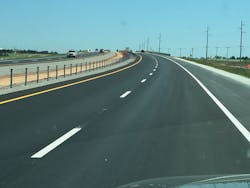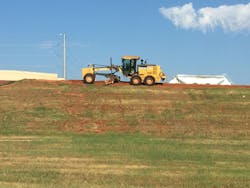Working religiously
They attended to the church regularly.
Old State Highway (SH) 74 in Oklahoma City had been servicing cars for about a century, and the two-lane road, which was without shoulders, had been out of its element for years. With an average daily traffic of 30,000 (about 30% coming from trucks) people had completely lost faith in the route’s abilities. The Oklahoma Department of Transportation (ODOT) knew it was time to serve the steel congregation, and in early 2015 work began on a brand-new stretch of road. The Crossings Community Church, however, was not going to make it easy on construction crews. Not only did the place of worship hold service every week, but it also educated children every workday. Prime contractor Haskell Lemon needed traffic—as well as its huge fleet of equipment—to run smoothly because people were watching, including ODOT director Mike Patterson and the head of the Oklahoma Turnpike Authority, Tim Stewart, who were members of Crossings Community. Haskell Lemon knew it had to get a firm grip on the situation from the very beginning.
“We had plenty of high-level observation every weekend,” Jay Lemon, president of Haskell Lemon, told Roads & Bridges. “Luckily they are good friends of ours and they did not hesitate to call and offer suggestions—and also praise.”
Haskell Lemon made plenty of new friends following completion of the $32.5 million project, which began in February 2015 and lasted until May 2016 and consisted of 16 lane-miles. The commute through the area, which now features a full interchange at North 150th Street and a traffic-signal-controlled interchange at North 164th Street, now lasts only minutes. What was once only two lanes of travel is now a comfortable four- and six-lane divided highway with shoulders and two service roads. The project received a Quality in Construction Award from the National Asphalt Pavement Association in January 2017.
The project was broken into three main phases.
Away from traffic
The jobsite was located about 300 ft to the west of the existing SH 74, which meant during the first nine months of work crews did not have to worry about traffic. Traffic was moved over to the new west service road so the old pavement could be demolished and the rest of the project could be completed.
“It was very unique in that we were able to do the biggest majority of this work and not have to deal with traffic,” Terry Wells, vice president over construction for Haskell Lemon, told Roads & Bridges. “That doesn’t happen very often in an urban area like Oklahoma City.”
Clearing the new footprint involved the removal of old farm ponds that “had been stilted in for years” and relocating water and sewer utilities.
The area did have an environmental trouble spot. There was evidence of groundwater contamination on one of the neighboring properties, so there was quite a bit of monitoring. The contamination came into play only when crews reached a depth of 16 ft in certain areas.
“So when we were in there excavating, we had partner companies that were in there monitoring air and water samples all day long,” said Wells. “If any of those levels exceeded certain thresholds, we had to stop and there was a remediation plan in place. We never reached any of those thresholds.”
Three creeks called for the installation of box culverts because the old SH 74 was prone to flooding. A 12-ft by 8-ft triple-reinforced concrete box 531 ft long, a 10-ft by 6-ft single-barrel reinforced concrete box 551 ft long and a 6-ft by 4-ft concrete box 567 ft long were all dropped into place.
The final roadway beat density requirements and now provides a smooth ride along SH 74.
Once the area was open, Caterpillar 637 scrapers and 831 compact rollers worked in the 8-in.-thick subgrade, which contained fly ash. A John Deere 672 with automated machine controls spread the fly ash while a Caterpillar RM 500 added water and handled the mixing. Three Ingersoll Rand SF-125 sheepsfoot rollers operating in vibratory mode compacted the dirt. ODOT demanded a 95% density of the fly ash modified subgrade, and with six passes crews were hitting 98% pretty consistently.
The west service road was the first to be paved. On top of the subgrade, paving crews dropped a 5-in.-thick asphalt base that was made up of an ODOT S-3 PG 64-22 asphalt mix with 1-in. rock. A Caterpillar AP1055E paver with Cat Grade Control and a ski created the mat on the jobsite. A Roadtec Shuttle Buggy also was used. A pair of Caterpillar CB54 XW steel double-drum rollers served as the breakdown, one operating in static mode and the other working in vibratory mode. They were followed by a Bomag BW27 pneumatic roller and a Dynapac CC522 steel double-drum, which served as the intermediate and finish rollers, respectively.
It took a total of 11 passes—seven in breakdown, two in intermediate and two in finish, to reach a density range of 92-97%. A Troxler non-nuclear gauge was used about once an hour to check for density. Haskell Lemon also took cores daily.
The 3-in.-thick intermediate layer contained an S-3 PG 76-28 mix with 1-in. rock, and the 2-in.-thick surface mat called for an S-4 PG 76-28 mix with 5/8-in. chips. The rollers that were used for the base mix were the same for the intermediate and surface lifts, and density also was achieved in 11 passes.
The 2-in.-thick surface mix was used for both the 4-ft-wide inside shoulder and 10-ft-wide outside shoulder.
Supplying the asphalt to the job was a CMI 450-ton asphalt drum mix plant located 12 miles from the project. It produced a maximum of 400 tons per hour. The asphalt was 325°F coming out of the plant and was 300-320°F at laydown. The asphalt content for the S-3 mixes was 4.5% and the air voids were 4.2%. The asphalt content for the S-4 mix was 4.8% and there was a 4.3% air void average. Haskell Lemon used both hot-mix and warm-mix asphalt to create the new SH 74, and the intermediate mix also contained 25% reclaimed asphalt pavement. The recycled material came from the old SH 74 (a Roadtec 900 handled all of the milling operations) and a stockpile at the Haskell Lemon yard.
A motor grader sculpts and smoothes shoulder dropoff, which helped define the final road surface.
In areas where there was no traffic Haskell Lemon paved both the inside shoulder and inside lane (16 ft wide) in one pass, before paving the other 12-ft-wide lanes.
“We would sequence our job to match the cold joints the day after we laid the first pass so we didn’t have those joints exposed to construction traffic, the weather or the elements for very long,” Casey Hawkins, project manager for Haskell Lemon, told Roads & Bridges.
The project was broken up into three main phases. After the west service road was complete, traffic was moved over so work could begin on the four-lane divided highway. The east service road was worked on last.
The intersection at North 150th Street came with all the bells and whistles—on- and off-ramps, Texas turnarounds, turning lanes and two new bridges. At the 164th Street interchange, crews had to deal with an 8-ft elevation change. At any given time there were as many as 16 different events happening simultaneously, which required constant communication and Hawkins spending most of his time on-site, directing traffic.



